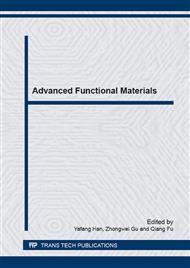p.412
p.424
p.429
p.434
p.440
p.446
p.451
p.458
p.464
Structure Changes of Coating on NiTi Alloy Prepared by Micro-Arc Oxidation in Na2SiO3 Electrolyte
Abstract:
Nickel titanium is a near-equiatomic intermetallic that possesses distinctive and desirable thermomechanical properties. Micro-arc oxidation (MAO) treatment of NiTi can effectively prevent the release of Ni ions from NiTi. In this paper, NiTi is treated with MAO method in Na2SiO3 electrolyte. MAO process of NiTi in Na2SiO3 electrolyte contains two stages: “growth period”, “jumped period”. During the process of MAO, Ni in NiTi is oxidized to Ni ion, and the Ni ions are dissociated in electrolyte. Ti was left in NiTi, which generate much Ti content appearing on the surface of the sample, and contribute to prerequisites for the reaction. After the applied voltage reaches a certain value, Na2SiO3 electrolyte participate in the reaction and form insulating amorphous silicon oxide layer. With the increase of thickness of insulating layer on NiTi, the anodic voltage increase. When applied voltage excess certain threshold, discharge spark appear on the surface of NiTi.
Info:
Periodical:
Pages:
440-445
Citation:
Online since:
March 2015
Authors:
Keywords:
Price:
Сopyright:
© 2015 Trans Tech Publications Ltd. All Rights Reserved
Share:
Citation:


